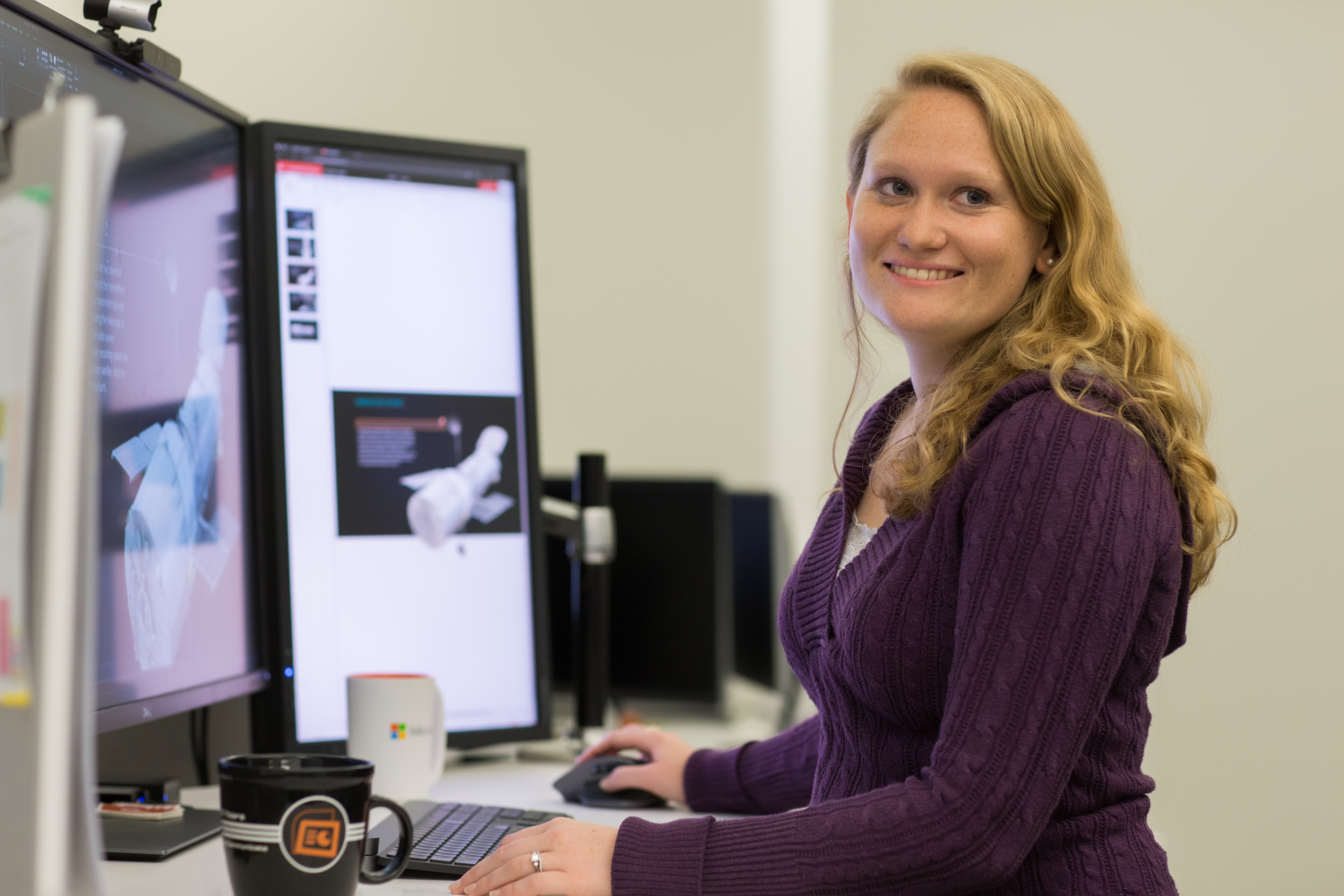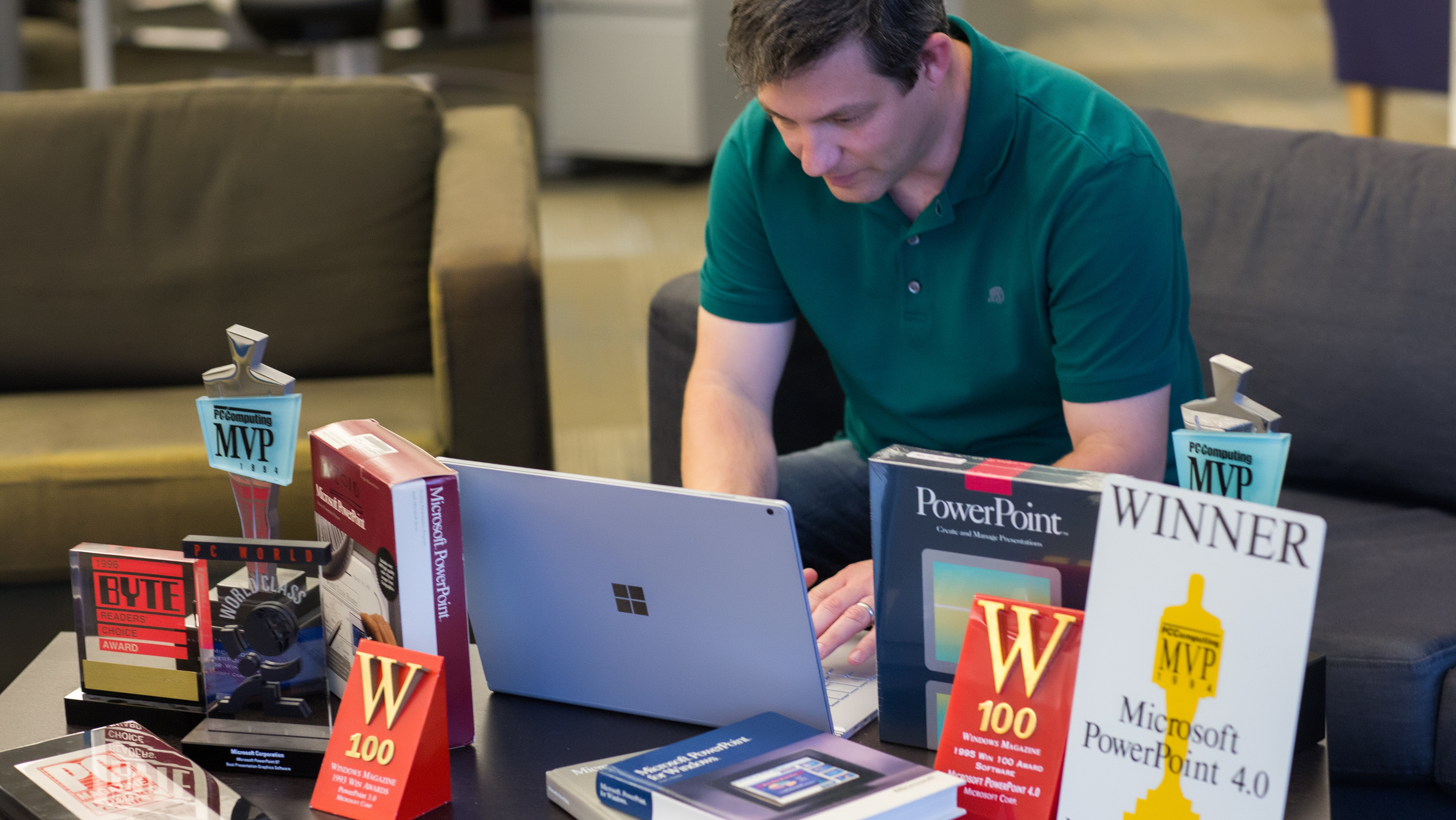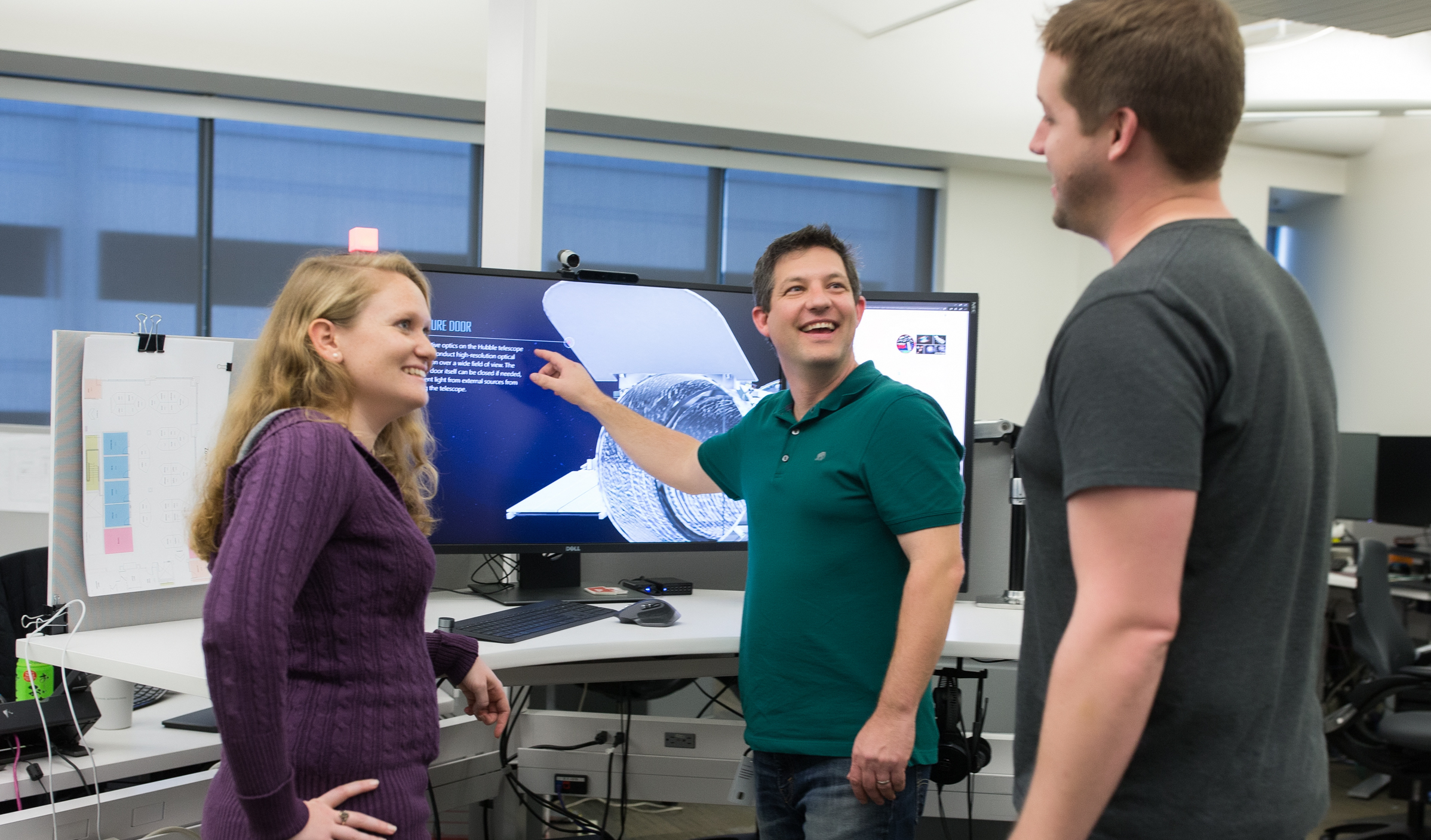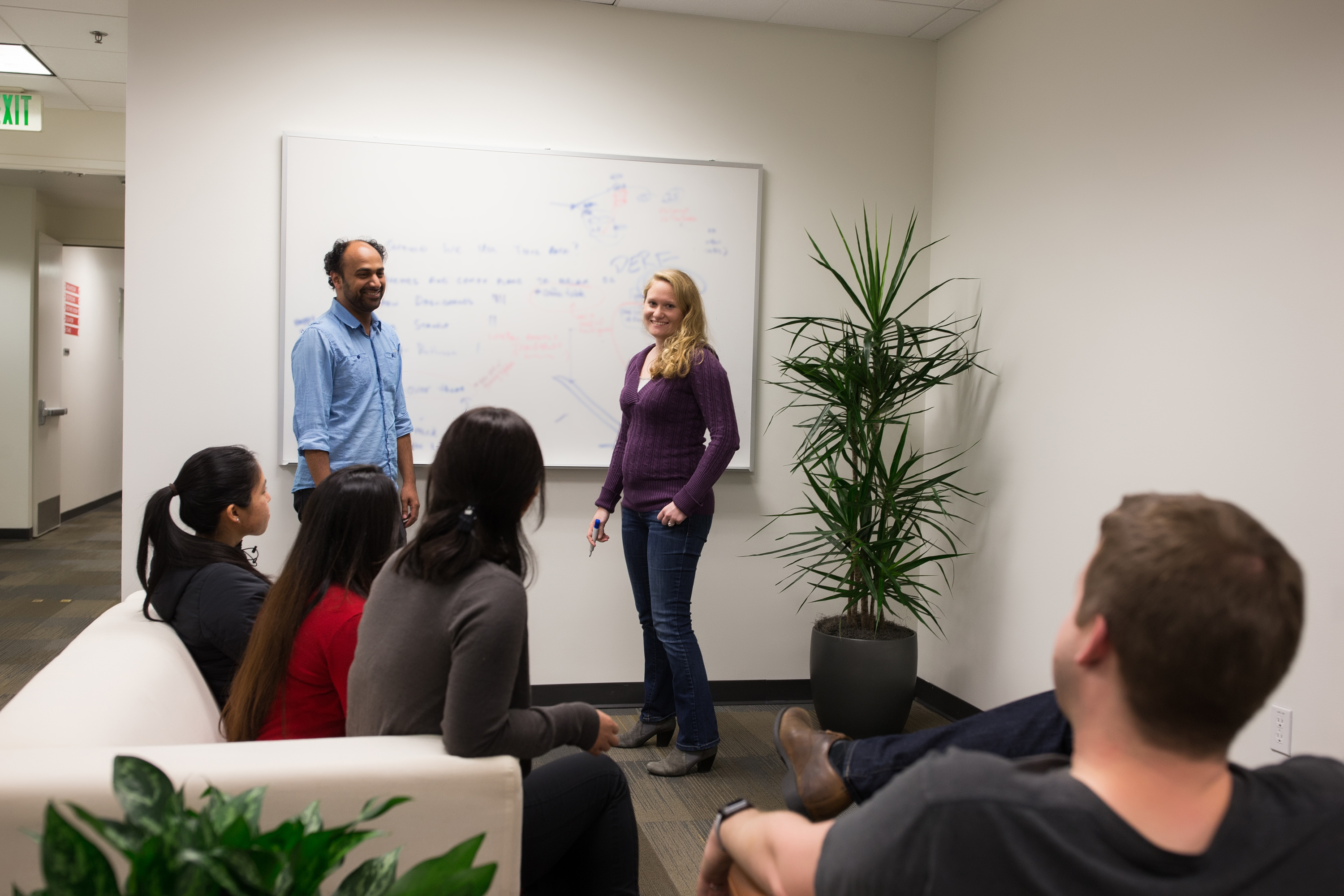After 30 years, the PowerPoint team is attuned to its competitors and constantly innovating.
PowerPoint stays in Silicon Valley, where competition is close
In Silicon Valley, high-tech competition is everywhere. You encounter rivals at dinner parties, soccer games, and the grocery store. They’re constantly challenging your company and your product, questioning the foundation of your work.
“When you hear things like that, it causes your heart to beat a little faster,” said Shawn Villaron, partner group program manager for PowerPoint. “It causes you to think a little more clearly. It causes you to start thinking, ‘Hey if they’re right, what do we need to do?'”

It’s the channeling of that drive that pushes Shawn’s team to make PowerPoint a consistently relevant tool. With roots in the hypercompetitive environs of Silicon Valley and a fired-up spirit of hacking, the team is relentless in its mission to do more for its customers.
“There’s definitely this feeling that if we all went on vacation for a year, when we came back we would have no customers. There’s always someone who is ready to step up and take away our spot. But if we keep coming up with great things and earn our customer loyalty, we should be able to beat the competition,” said Sarah Ferraro Stein, a senior software engineer who’s been with the team (and Microsoft) since 2012.
This is a product born and built in the valley. Over 30 years, it’s grown and evolved by staying there, taking advantage of the future of computing, communication, and productivity. And yet throughout all of those changes, it has continued to be the tool of choice for millions of people needing to tell their story.
The PowerPoint team’s efforts have led to a product that has changed the way business is conducted across the world, from classrooms to boardrooms.
Governments use it to shape policy and influence the future of humanity. Corporations and small businesses use it to run the engines of growth, powering the world economy. Entrepreneurs use it to secure capital for the next big thing. Teachers use it to teach the next generation. Parents use it in community organizations. Artists use it to inspire and provoke. Children use it to convey what they’ve learned.
To continue evolving PowerPoint to meet the business and technology needs of a digitally transforming world, its developers have found new ways—spurred by the Silicon Valley spirit of entrepreneurship and a growth mindset—to blend creativity and collaboration into a tool whose longevity has been buoyed by innovation.
“This team is amazing because of the diversity of ideas. We have a lot of strong experts on the product and a bunch of new people who have all these crazy new ideas. Together, we figure out what works best for our product.” (Sarah)
A better way to share ideas
As a pillar of the Office suite, which has sold more than one billion licenses worldwide, PowerPoint is a standout as a communication tool that evolved from days when overhead projections and transparencies were the norm. In those days, Robert “Bob” Gaskins—who worked for a Silicon Valley startup called Forethought—realized there was a better way to give visual presentations by using personal computers.
Forethought introduced PowerPoint on August 20, 1987, on Apple Macintosh. On July 30, 1989, Microsoft acquired the company (and PowerPoint) for $14 million. It wasn’t long before the program was ubiquitous.

“Even back in the early 1990s everyone was using PowerPoint,” Shawn said.
“One of the things that is truly differentiating in PowerPoint is the degree to which we curate our code base. I think that plays a central role in our ability to be agile and to try things and fail fast,” Shawn said. “Even if we had this great culture and interesting point of view informed by Silicon Valley, if we didn’t have that solid code base, we couldn’t do it. That is something that goes back to our roots.”
“We’re trying to move PowerPoint in this direction where instead of thinking of it as a toolbox, it’s an assistant. We’re going to help you be successful. And to me that’s one of the biggest challenges in PowerPoint’s history.” (Shawn)
Over the years, it’s grown. PowerPoint became one of the core apps in the Microsoft Office suite, and it evolved beyond Windows and Mac to Android, iPad, iPhone, Windows 10, and web browsers. The app adopted basics like color, printing, photos, and spell checker. But it also introduced animations, transitions, and video support. Users could also customize it and build on top of it. It also expanded to languages around the world, gaining new fans globally. More recent advances include the Designer service, which helps create high-impact slides; Morph, which helps users easily tell their story through animation; real-time collaboration; and the presenter view, which helps users deliver the best presentation possible.
Thirty years later, PowerPoint is still at the top of its game, but it’s also a much more crowded playing field.
The culture of constant innovation is ingrained in the team, something Shawn—who has worked on PowerPoint since 1996 and started as a program manager when the group numbered 60-70 employees—has known since he was an intern in 1994 tasked with researching competitive products.

We did not rest on our laurels,” Shawn recalled. “We understood that things could change at any moment. We weren’t going to assume we were the best; we weren’t going to disrespect or dismiss our competitors. We had to be willing to learn from our competitors, all the while trying to out-execute them.”
PowerPoint has been evolving since its launch, but several years ago the team leadership was looking for new ways to give their team members a voice in the evolution of the product and infuse energy into the team. Dachuan Zhang, partner group engineering manager on PowerPoint, suggested trying a hackathon as a morale event.
Shawn was doubtful at first, thinking the engineers would prefer something more fun. But then he realized engineers want to learn, build, and experiment in a safe, collaborative environment.

That first hackathon took the whole team offline for almost four days—an expensive experiment.
But Shawn said that participation was “unbelievably high” and produced phenomenal results. The hackathons also showed the leadership team just how well the team understood their business strategy, technical challenges, and what customers were longing for. He and other senior leaders appreciated how participants put their own spin to create “mind-blowing” and “unconventional” solutions.
Thinking forward through hacking
To foster cycles of new ideas, the PowerPoint team, which includes about 175 people, now has regular hackathons, inviting everyone from the newest intern to the most senior engineer, designer, and program manager to think about how they can evolve the product using work hours, hacking for innovation.
“It’s not always easy to get your ideas out there. Hackathon is when management says, ‘I just want to hear what you are interested in and want to see what you can do.’” (Sarah)
Sarah, who came to the company right after she graduated from Harvey Mudd College, has participated in all the PowerPoint hackathons since she’s been at Microsoft.
“Sometimes I just do simple things like improve a tool that I work with every day,” she said. “Most recently I did one that was more feature oriented where we added a feature to PowerPoint Online which we call Share a Slide.”
With this feature, users can pick one slide to share with others, instead of an entire deck.

“It’s very much a collaboration feature. And so that was pretty cool,” she said. “It got a lot of excitement on the team.”
The two most recent hackathons saw the introduction of hack tanks (think of the show “Shark Tank”) where the best hacks from the hackathons go before the senior leadership for an opportunity to be officially picked up and funded as part of the official PowerPoint plan. Sarah’s hacks haven’t made it to a hack tank yet, but the team is thinking about how to work in Share a Slide in future updates.
Several product features have come out of the PowerPoint team hackathons, including Morph, 3-D, and improvements in the Smart Guide code that helps align two or more shapes on a slide. Intelligence features also came through these sessions, such as PowerPoint Quick Starter.
“We’ve seen everything from hackathon projects that were so good, so refined, so high quality that we spent a week sort of cleaning them up and we shipped them to customers,” Shawn said. “We’ve seen cases where the engineer has unlocked the potential of a feature we weren’t sure we could build, and they’ve done enough to convince us that something we weren’t sure about really was something that we could tackle and ship it to customers.”
Even ideas that don’t progress to a feature that gets shipped to customers are useful, the team has found.
In some cases, Shawn said, “it is not so much ‘do we fund the feature,’ but it’s more about updating the way we think of PowerPoint. What is it and where does it need to go in the future? And to me that’s the most exciting stuff, for the impact might span years, well beyond any one feature.”
It’s that forward-thinking perspective that resonates so well with Satya Nadella’s vision for growth mindset, Shawn said.
“We don’t know how this is going to play out in the next 5, 10, or 15 years. We don’t always have the answer for what the next step is. And so we’re really trying to change the way we run the team, to give everyone a voice in the direction of the product,” he said. “[Hackathons] show us ways forward that we hadn’t thought of. Ultimately, it changes the narrative of how we think about PowerPoint, its role today, and its role tomorrow. Give everybody a voice; we need to have that growth mindset of asking questions and listening.”
Find out more through the below video about how the PowerPoint team is moving forward through their culture and creativity.
Lead photo: The PowerPoint team. Photo by Tyler Mussetter.




